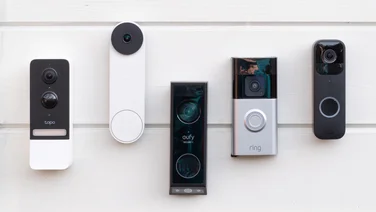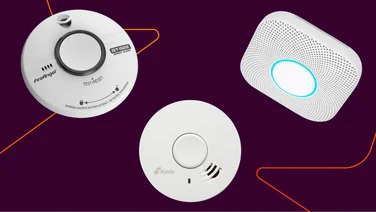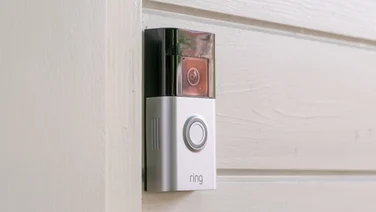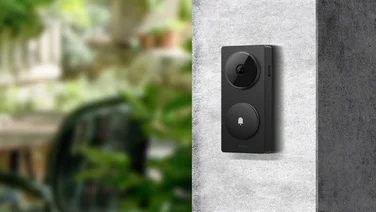To help us provide you with free impartial advice, we may earn a commission if you buy through links on our site. Learn more
- Ring Battery Video Doorbell Plus review: What do you get for the money?
- Ring Battery Video Doorbell Plus review: How easy is it to install?
- Ring Battery Video Doorbell Plus review: What does it do well?
- Ring Battery Video Doorbell Plus review: What could it do better?
- Ring Battery Video Doorbell Plus review: Verdict







- Wide vertical field of view
- Easy to install and use
- Delivers activity notifications quickly
- Monthly subscription required for some features
- Chime not included as standard
The Ring Video Doorbell Plus is the latest in Ring’s ever-expanding range of smart video doorbells and it brings a number of improvements over the regular model, not least a wider vertical field of view and sharper resolution.
It isn’t the cheapest way to get a Ring doorbell and it misses out on some of Ring’s more advanced features, but we think it’s the best smart doorbell for most people – as long as you don’t mind paying Ring’s usual £3.49 monthly subscription fee.
Ring Battery Video Doorbell Plus review: What do you get for the money?
The Ring Video Doorbell Plus works like most other smart video doorbells. Install the app on your smartphone and you can see who’s at your door and speak to them from wherever you happen to be. You can also record video clips automatically of anyone approaching your house or ringing the doorbell.
This Plus model sits in the middle of the Ring doorbell range and costs £160. As with most Ring video doorbells, what you get in the box is fairly limited. You get the doorbell itself, one rechargeable, quick-release Lithium-ion battery and all the fixings you’ll need to install it on your door frame or wall. There’s no bundled chime in the box but you can add one at the point of purchase for an extra £10.
Ring does include a plastic wedge-shaped bracket for angling the camera towards the centre of the door and a screwdriver with a Torx security bit for accessing the battery compartment, but it doesn’t supply a wireless chime or a bracket for angling the doorbell downwards. Those you’ll have to pay extra for. You also have to pay a subscription fee (from £3.49 per month or £5 per month from 11 March 2024) to record and access video clips in the cloud, as the Video Doorbell Plus has no means of storing the files locally.

The key differences for the Ring Doorbell Plus are in the video department. Where most other Ring doorbells are limited to 1080p, the Plus records video at 1536p and has a wider 150-degree field of view, both vertically and horizontally. The latter comes in particularly useful for seeing if packages have been left on your doorstep, although there’s still a gap of around 40cm at the bottom of your door that you won’t be able to see.
That broader, sharper view does come at the expense of some advanced features, however. For instance, the Doorbell Plus has no 3D motion detection, like the Video Doorbell Pro 2, nor any kind of pre-roll video capture. It does offer colour night vision but, in reality, this doesn’t add much over regular infrared-based monochrome night vision. Footage still looks pretty murky, whatever mode you choose.
READ NEXT: The best home security cameras to buy right now
Ring Battery Video Doorbell Plus review: How easy is it to install?
The Ring Doorbell Plus is primarily designed to be used with its battery but you can opt to connect it to your existing mains doorbell power via the two spade connectors on its rear or, alternatively, if you get tired of having to recharge the battery, you can purchase an adapter that can be plugged directly into a standard three-pin plug socket.
Whichever way you choose to power it, though, it’s a doddle to set up. Just charge it up, download the Ring app (if you don’t have it already) and add the camera by pressing the plus symbol in the top right corner of the main screen. The app then walks you through every stage of the setup process, including Wi-Fi connection and installation, and it also walks you through most of the camera’s features.

As part of this process, you’re given the option to set up motion zones so that the camera doesn’t activate when you don’t want it to. For instance, when someone walks by on the pavement at the end of your garden path, or if the postie strolls down your neighbour’s drive. Ring takes this even further than most doorbell manufacturers, allowing you to set up Privacy zones as well.
Privacy zones allow you to black out areas of the frame, which is useful if your camera is, for example, positioned so that it captures part of a neighbour’s property.You also get the option, at this stage, whether or not to enable package detection. You might as well, because it seems to work reasonably effectively, although be aware that Ring warns that it won’t work well with packages smaller than 25 x 25 x 25cm in size and that it can’t detect envelopes, tubes and grocery bags.
I found that smaller packages worked quite well, in fact, as long as they were brown, but just as Ring warned, the Video Doorbell Plus ignored envelopes, tubes and bags.
Perhaps more useful than this, however, is the doorbell’s Quick Replies feature, which lets you choose a recorded message that will play automatically once the doorbell has been pressed. This is particularly useful if it takes you a while to get to the front door.
Ring Battery Video Doorbell Plus review: What does it do well?
I was particularly impressed with the performance of the Doorbell Plus. It typically took a mere three seconds from pressing the button to receiving an alert on my phone, and it was this quick regardless of whether I was connected to my home Wi-Fi network or the local 5G network.
The wide field of view is useful, too, capturing video that’s as tall as it is wide – this is much more useful than the widescreen view that other Ring doorbells offer. Another feature I like that appears again here is Snapshot, where the camera captures still images at regular intervals (either every hour or every 14 minutes), so even if there’s no activity, the thumbnail always shows roughly what the camera is seeing.

As I’ve found in previous reviews, the Ring app’s user interface is very easy to get to grips with. The timeline, in particular, is a doddle to navigate and it’s quick and easy to scrub back through the timeline to see when packages have been detected, when you might have missed a visitor or when people have arrived or left home via the front door.
Plus, if you have a lot of video clips to hunt through, you can filter by event type – by person, package or doorbell ring – to make your search easier.

Ring Battery Video Doorbell Plus review: What could it do better?
If you want to continue using the full range of features once the 30-day free trial has finished, then you have to cough up for a Ring Protect subscription: this comes in several flavours but none of them is particularly cheap, particularly compared with the competition.
The core features will still work without a subscription: the app will notify you when someone has rung the door or if motion has been detected and you’ll still be able to see, live, who is at the door from wherever you are in the world and talk to them. However, you won’t be able to store or download motion-triggered video clips, use any of the motion zone features or enable package alerts.

So how much does Ring Protect cost? If you only have one Ring camera, Ring Protect Basic will cost you £3.49 per month or £35 per year if you pay up front (note, this is rising to a rather pricey £5 per month or £50 per year from 11 March 2024). This lets you store video for up to 180 days in the cloud (the default is 30 days), download up to 50 videos simultaneously and access advanced features such as snapshot capture, package and person detection, and motion zones. For those with more than two Ring cameras, the Ring Protect Plus subscription makes the most sense, costing £8 per month for an unlimited number of cameras in a single household.
If you’re worried about subscription costs, however, you should probably take a look at other systems. The Nest doorbell and camera system, for instance, offers some free storage by default and although there’s no single camera plan, it costs less per month for multiple camera coverage at £5. Both Eufy and EzViz doorbells, on the other hand, can record to local storage and can be run without the need for a subscription at all.
I also find it slightly bizarre that privacy zones can only be set as squares or rectangles, especially when detection zones can be any shape you like. You can deal with irregular shapes by drawing multiple squares and rectangles but as you’re limited to only two zones, you might have to compromise on what’s blanked out and what’s visible.
Ring Battery Video Doorbell Plus review: Verdict
If you’ve yet to take the smart doorbell plunge, it’s worth looking into the alternatives from Google, EzViz and Eufy before making your final decision. These alternatives are cheaper to run (especially since the Basic Ring Protect plan rises to £5 per month from 11 March 2024) and, in some cases, considerably cheaper to buy as well.
If, however, you’re already sold on the Ring system and you’re looking to upgrade your doorbell from the basic model, the Ring Video Doorbell Plus is a solid improvement. Its image quality is excellent, and it’s both responsive and easy to use once installed. It doesn’t come with Ring’s most advanced features but, frankly, they’re overkill for most homes – for everyone else, this is the best Ring doorbell you can buy.
READ NEXT: The best video doorbell to buy today






